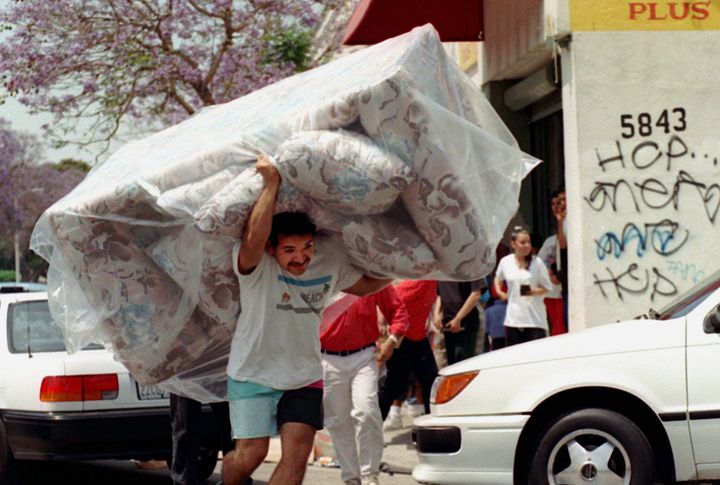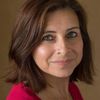
From an apartment in Biloxi, Miss., I watched on TV as Los Angeles burned, rioted and turned itself inside out on April 29, 1992.
Days before, I had stepped off a plane from Naval Station Roosevelt Roads in Puerto Rico where I had been stationed.
I was in the process of getting discharged from the U.S. Navy after having served four years. I was about to hang up my olive-green Seabee uniform, hard hat and combat boots to embark on a new adventure that year -- one that involved getting married, having my first child and becoming a full-time college student.
But 1992 was a critical year for me for another reason. Unbeknownst to me at the time, I was in the process of growing a social and racial consciousness that would impact every decision I made thereafter.
Flash forward 20 years to a few days ago. I joined over 300 young and seasoned social activists and community organizers attending the Program on Environmental & Regional Equity (PERE) at the University of Southern California conference, "From the Ashes: The 1992 Civil Unrest and the Rise of Social Movement Organizing."
Young and old, black and brown, Asian and white -- people gathered to reminisce about where they were that day and reflect on the social justice movement that deepened, evolved and grew from the events and lessons of the Civil Unrest. There was lots of sharing and "where were you on that day?" The younger activists were at times apologetic. Some admitted they were barely out of diapers when the civil unrest occurred and their memories were fuzzy.
The opening panel included veteran organizers of the Los Angeles social justice movement, including Dr. Manuel Pastor, the director of PERE, Danny Park of the Koreatown Immigrant Workers Alliance, Maria Elena Durazo of the AFL-CIO and Anthony Thigpenn, the founder of Strategic Concepts in Organizing and Policy Education (SCOPE) and California Calls, an alliance of more than 25 grassroots organizations in the state.
Thigpenn was driving when the rebellion, as he describes it, broke out. His first concern was for his staff. The office was just five blocks from the epicenter.
"For many of us, the 1992 rebellion was a wake up call," Thigpenn said. "I felt very keenly the need to come back home and build vehicles so that the legitimate anger and expression people were feeling had a place to express itself in a more strategic place."
He added, "Our communities were under siege. We were on the defensive."
I was particularly intrigued by what Thigpenn had to say because it's humbling to work for someone with such an incredible depth of experience. He's the real deal.
Thigpenn has been involved in the social justice movement since he was a high school student in the late 1960s in Watts, where he grew up, organizing a "rainbow coalition" of African-American and Latino students. He has roots in the Black Power Movement as a member of the Black Panther Party, and prior to the civil unrest he was the executive director of Jobs with Peace and the Unity Workshop.
"We had a lot of experience with fighting the good fight and losing," he told the chuckling audience who had packed the auditorium at USC.
At California Calls, we're building a statewide civic engagement program to mobilize 500,000 new and occasional voters in support of long-term tax and fiscal reform. The model for our statewide work is based on SCOPE's experience and history, which has increased voter turnout among South L.A. residents. This is the inspiration for our work.
Going back to that day 20 years ago, it's clear to me that the events that transpired not too far from my hometown left a mark on me as well, but for different reasons. My soon-to-be husband and his white military buddies watched the horrific images on TV with me. They described the civil unrest in ugly, racist terms. Awkwardness and discomfort ensued when I told them to refrain from talking that way in my house. My outspokenness made me unpopular around some crowds but staying silent has never been my thing.
A month after the civil unrest, I got married on a dairy farm in Tennessee. My new in-laws were kind to me but they were also unabashedly racist. They lived in a town just a few miles away from where the Ku Klux Klan was founded. The "n-word" was used in casual conversation. They chose not to eat in restaurants with black cooks. All of this affected me deeply. For one, my best friend since the age of 9 is African-American.
My former father-in-law claimed the Klan were a group of Christian men with good morals who had gotten a bad rap from agitators. We had many "discussions" that led to nowhere fast.
All told, I'm happy I had these experiences because they ended up piquing my curiosity -- and inflaming my passions for fighting for the underdog. I began to voraciously read up on the Civil Rights Movement and the Klan. Who knew the past could be so interesting? My recollection of history from high school was that it focused an awful lot on white men, wars, military leaders, kings and queens and, on the flip side, powerless serfs, peasants, slaves and indentured servants. These lessons had bored me. While living in the South, I embarked on a solo "field trip."
I visited what was then the tiny Selma Voting Rights Museum at the foot of the Edmund Pettus Bridge. I stopped in Money, Mississippi, where Emmett Till was brutally murdered and Philadelphia, Mississippi, where three civil rights workers were killed during Freedom Summer. I drove back and forth on Highway 80 until I finally spotted Viola Liuzzo's marker from my car. The Klan gunned down this white Michigan mother of five after the Selma to Montgomery march. Other notable stops included the 16th Street Baptist Church in Birmingham where four little girls were brutally murdered in a bombing and Kelly Ingram Park where vicious police dogs, dangerous fire hoses and a man named Bull Connor could not stop righteous and peaceful young children from demonstrating. Back then, the Birmingham Civil Rights Institute was brand-new and a pleasure to visit.
I didn't know this then but I was yearning for a Howard Zinn version of history and searching for new and unsung heroes.
When my then husband was transferred to Maryland and I was accepted into St. Mary's College of Maryland, I finally got my wish. I majored in history with a focus on social justice movements, particularly African-American history. In college, I learned about oppression and the structures that had been put in place that kept people of color, and women, from playing on a level playing field.
Three years later, I transferred to the University of Southern California because I wanted to study print journalism. When I became a reporter, my background in history helped provide fodder for many of the story ideas I came up with. As a journalist, the past was always present and my lens as a writer was colored by my past experiences and my own identity.
Twenty years later, I feel things have come full circle for me. I am working for California Calls, an organization whose aim is to revitalize the California Dream for everyone, but especially the poor and working class.
I'm becoming more and more immersed in the world of social justice in the heart of South Los Angeles. I am home.
